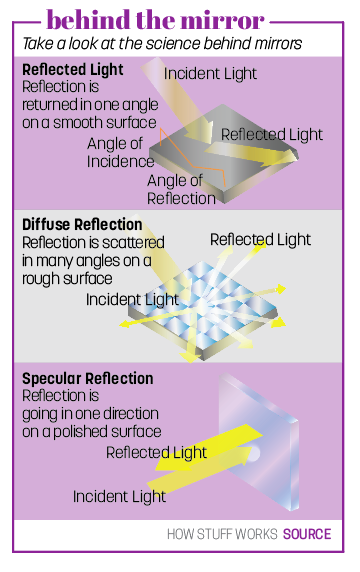
As a teenage girl, I’ve experienced varying levels of comfort in my own skin. But for the most part, through the positive rhetoric circulating beauty standards in today’s world, I’ve grown to love how I look and be happy with who I am.
Recently I was shopping for clothes at Clay Terrace, and I noticed I looked weird in the dressing room mirror after trying on a sweater. Upon closer inspection, I realized the mirror was distorted, making me look much skinnier than I actually am.
These so-called “skinny mirrors” became well-known in 2015 after Belinda Jasmine-Bertzfield proposed a similar idea on Shark Tank. Since then, I’ve heard various stories about how stores use tactics like these mirrors to increase sales, but never having experienced them firsthand, I cast these stories off as rumors.
 Seeing these appear in a mall I have visited countless times, I was appalled. Why would a store want to use such underhand tactics to get more sales and leave customers less satisfied with their products than they had initially been?
Seeing these appear in a mall I have visited countless times, I was appalled. Why would a store want to use such underhand tactics to get more sales and leave customers less satisfied with their products than they had initially been?
What is most interesting to me about these mirrors, though, is how absurd they seem when I put them into the context of modern life. In the past decade, Miss Teen USA removed its classic swimsuit contest, Sports Illustrated featured a plus-sized model on its cover, and I’ve noticed more body-type representation in ads in general. These are some of the many efforts media outlets have made to be more inclusive and celebrate the beauty in all body types. The average weight of models is still 23% less than the average woman, but these efforts are a start for reversing this image.
But after experiencing these mirrors, I am not sure what to believe. Skinny mirrors go against this body-positive ideology; at their root, they assume people will buy more when clothes make them look skinny, reinforcing the idea that you should like yourself better when you are skinnier than how you are now.
I hope in the future, stores will refrain from using skinny mirrors as a sales tactic. Although The Skinny Mirror company does claim using these mirrors can boost sales by up to 18%, using these mirrors could attract negative publicity, which could hurt a store in the long run by dissuading new customers from shopping there. Plus, with a growing modern culture that strives to celebrate all body types, customers might question the company’s values and become less loyal to the company because of the correlation these mirrors imply between being skinny and looking good.
More importantly, I hope students are aware of these mirrors and are wary of the message they send. To me, this surprising experience was an important lesson that, when buying clothes in store, I should focus on how comfortable they are and how good they make me feel instead of focusing too much on how they make my body look. And I hope you remember these same ideas the next time you go shopping because reflections don’t always accurately portray what’s on the other side of the mirror.
The views in this column do not necessarily reflect the views of the HiLite staff. Reach Rhea Acharya at racharya@hilite.org.
Click here to view an Acumen issue that has a theme of mirrors.































![What happened to theater etiquette? [opinion]](https://hilite.org/wp-content/uploads/2025/04/Entertainment-Perspective-Cover-1200x471.jpg)














































![Review: “The Immortal Soul Salvage Yard:” A criminally underrated poetry collection [MUSE]](https://hilite.org/wp-content/uploads/2025/03/71cju6TvqmL._AC_UF10001000_QL80_.jpg)
![Review: "Dog Man" is Unapologetically Chaotic [MUSE]](https://hilite.org/wp-content/uploads/2025/03/dogman-1200x700.jpg)
![Review: "Ne Zha 2": The WeChat family reunion I didn’t know I needed [MUSE]](https://hilite.org/wp-content/uploads/2025/03/unnamed-4.png)
![Review in Print: Maripaz Villar brings a delightfully unique style to the world of WEBTOON [MUSE]](https://hilite.org/wp-content/uploads/2023/12/maripazcover-1200x960.jpg)
![Review: “The Sword of Kaigen” is a masterpiece [MUSE]](https://hilite.org/wp-content/uploads/2023/11/Screenshot-2023-11-26-201051.png)
![Review: Gateron Oil Kings, great linear switches, okay price [MUSE]](https://hilite.org/wp-content/uploads/2023/11/Screenshot-2023-11-26-200553.png)
![Review: “A Haunting in Venice” is a significant improvement from other Agatha Christie adaptations [MUSE]](https://hilite.org/wp-content/uploads/2023/11/e7ee2938a6d422669771bce6d8088521.jpg)
![Review: A Thanksgiving story from elementary school, still just as interesting [MUSE]](https://hilite.org/wp-content/uploads/2023/11/Screenshot-2023-11-26-195514-987x1200.png)
![Review: "When I Fly Towards You", cute, uplifting youth drama [MUSE]](https://hilite.org/wp-content/uploads/2023/09/When-I-Fly-Towards-You-Chinese-drama.png)
![Postcards from Muse: Hawaii Travel Diary [MUSE]](https://hilite.org/wp-content/uploads/2023/09/My-project-1-1200x1200.jpg)
![Review: "Ladybug & Cat Noir: The Movie," departure from original show [MUSE]](https://hilite.org/wp-content/uploads/2023/09/Ladybug__Cat_Noir_-_The_Movie_poster.jpg)
![Review in Print: "Hidden Love" is the cute, uplifting drama everyone needs [MUSE]](https://hilite.org/wp-content/uploads/2023/09/hiddenlovecover-e1693597208225-1030x1200.png)
![Review in Print: "Heartstopper" is the heartwarming queer romance we all need [MUSE]](https://hilite.org/wp-content/uploads/2023/08/museheartstoppercover-1200x654.png)


